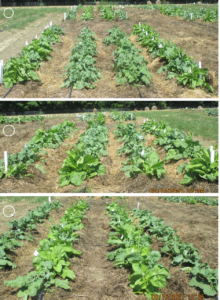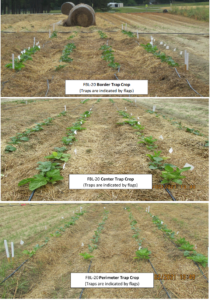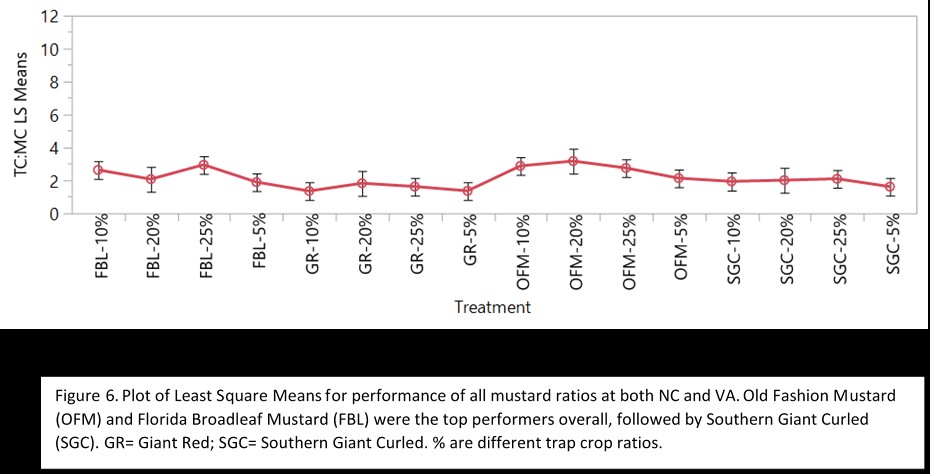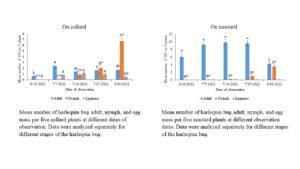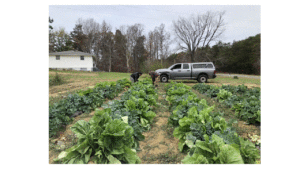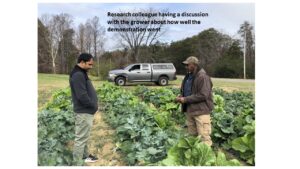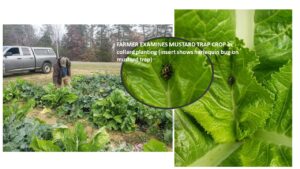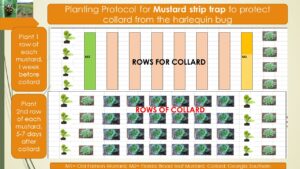Final report for LS19-311
Project Information
The proposed project explores the use of an existing concept on ‘Banker Plants’ in greenhouse IPM, to expand our knowledge and ability to manage the harlequin bug, an important field pest that attacks collard, kale, cabbage, broccoli and other crucifers in the Southeastern U.S. causing severe reduction in market value or death of the plants. The economic impact of this pest can be far-reaching especially among small growers who produce most of the collard and kale found in many U.S. market outlets. Collard, kale and cabbage, like other Brassicaceae, are attacked by an insect pest complex from seedling throughout crop growth. This results in extensive damage that warrants frequent and predictable application of insecticides to keep the pest below economically damaging levels, sometimes resulting in over $1 billion in management costs and crop loss. Cases of resistance by some crucifer pests to all classes of insecticides have been reported in the U.S. and elsewhere. Heightened public concern regarding excess pesticides use on vegetables and the documented negative effects have provided the impetus for increased research to find viable alternatives to pesticide dependence. The proposed research will build on and improve the efficiency of current deployment of mustard trap crops for HB control in the field, as well as provide a footprint for their use in other cropping systems using the banker plant concept — a greenhouse pest management approach. This will be accomplished by manipulating either the fixed intra-row or movable inter-row establishment of a banker trap crop (pest sink) positioned at different distances within or between main row crops. We will examine the effect of banker trap plants on overall HB attraction to, and retention on, the trap crop by assessing egg number and parasitization, nymphal and adult distribution between trap plants and main crop plants, damage to main crop, and leaf biomass at harvest. The density ratio will be modeled to enable adjustment for use with other pests in this or another agroecosystem thus giving the findings wider pest management application. This approach will reduce the area occupied by the trap crop, especially important in the case of a sacrificial trap crop which has no other value, and also provide the grower the flexibility of having the trap plants always available at the most attractive stage (if the mobile BTraP is adopted). The long-term goal is to reduce insecticide use in vegetable production, increase farm profits while enhancing food and environmental safety as well as well being in farm communities. It will also conserve natural enemies and pollinators. This project models existing knowledge from one area of science (greenhouse biological control) to accomplish a different pest management goal. Its success would hopefully foster enough interest and research on trap crop use to attract increased funding. The project targets small vegetable growers working in different agroecosystems but can be scaled to medium-sized farms. On-farm demonstrations will be established in conjunction with collaborating growers in North Carolina and Virginia.
- Using variable plant ratios to conduct laboratory bioassays and greenhouse cage studies to evaluate efficiency of “Banker trap Plants (BTraPs) established at variable fixed simulated intra-row densities using four different mustard varieties to obtain different trap crop:main crop ratios.
- Carry out field evaluation to a) validate the optimal ratios of the lab experiment and then b) determine the effect of the optimal fixed-BTraP ratios from Objective 1 and 2a, compared with movable BTraPs variants on harlequin bug attraction and retention on two recommended mustard trap crops.
- Conduct on-farm validation and the economic sustainability of the two best BTraP deployment systems determined from Objective 2.
- Perform an economic assessment of the various trap crop models in Objective 2 and their deployment in Objective 3 to determine benefit/cost optimization, overall system profitability and which model choice will be the best.
Cooperators
- (Educator and Researcher)
Research
Project objectives from proposal:
- Using variable plant ratios to conduct laboratory bioassays and greenhouse cage studies to evaluate efficiency of “Banker trap Plants (BTraPs) established at variable fixed simulated intra-row densities using four different mustard varieties to obtain different trap crop:main crop ratios.
- Carry out field evaluation to a) validate the optimal ratios of the lab experiment and then b) determine the effect of the optimal fixed-BTraP ratios from Objective 1 and 2a, compared with movable BTraP models on harlequin bug attraction and retention on two recommended mustard trap crops.
- Conduct on-farm validation and the economic sustainability of the two best BTraP deployment systems determined from Objective 2.
- Perform an economic assessment of the various trap crop models in Objective 2 and their deployment in Objective 3 to determine benefit/cost optimization, overall system profitability and which model choice will be the best.
Completed Objectives
Objective 1. The original sequence of this objective was altered because of the difficulties highlighted in the Preamble. The insect population in the lab crashed unexpectedly making it impossible to carry out the experiments as planned. We therefore started with the field experiment in a modified design which included all four mustards and the originally prescribed TC:MC ratios of 0, 5, 10, 20 and 25%. This also experienced problems with extremely heavy rainfall which led to flooded fields; crucifers are intolerant to flooded soils. Despite the poor stands that resulted we were nonetheless able to obtain some results which are reported here.
Field experiment: The experiment had two 5m-row plots x 4 mustards x 5 TC:MC ratios (0, 5, 10, 20 and 25%) arranged in a CRB with 3 replications (4 in VA); it was conducted at NCA&T State University (NCA&T) Research Farm in Greensboro, NC, and in the Virginia Tech Experimental Farm in Kentland, Blacksburg, VA. A locally adapted collard variety was used as the main crop; in NC the variety Georgia Southern, and Vates in Virginia.
Each 2-row plot had 20 plant stands, with some of them replaced by the different mustards according to the respective TC:MC treatments. These were randomly spaced out ensuring equal distance between them within the plot (Figure 1). Measurements were made by close direct visual inspection, on 5 previously tagged collard plants and up to 5 mustards/treatment plot) for estimates of harlequin bug (HB) adults and 3rd-5th stage nymphs, HB egg masses (oviposition) and flea beetle counts (Blacksburg only). At this stage collard yield was not the focus on yield since we let measurements continue through the season past the normal period for harvesting. No insecticide was applied except once (VA) and twice (NC) to reduce caterpillar damage, which tends to confound measurements taken for damage by HBs. Sampling was started two weeks after transplanting (DAT)—June 25th in Blacksburg and July 19 in Greensboro. The difference in the start of observations was due to heavy rains during the early part of the growing season which delayed transplanting in Greensboro.
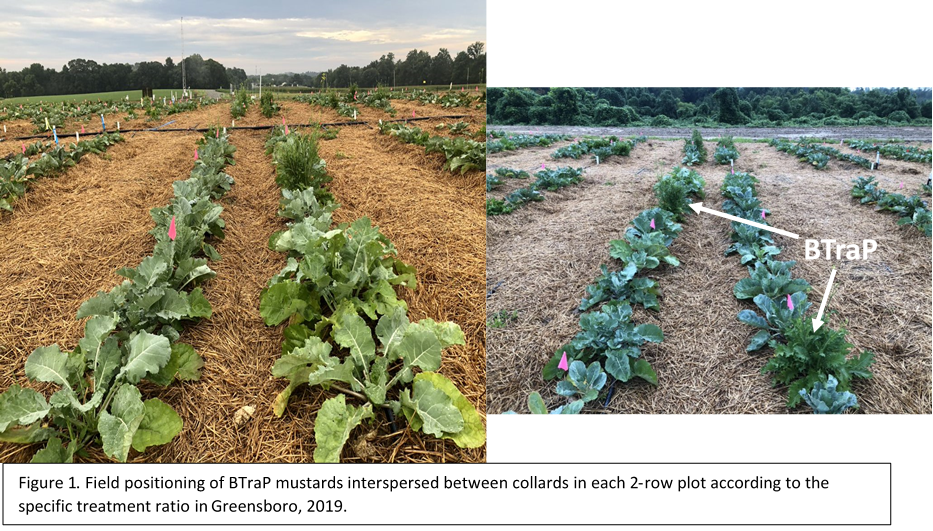
Laboratory study: This was supposed to be conducted before the field study but we had to revise the order when our laboratory culture crashed due to unexpected and still unclear reasons. We were able to resuscitate the culture mid-summer and run the arena choice test (Figure 2) which simulated different TC:MC ratios (0, 5, 10, 15, 20, 25%) in which we added another ratio, 15%, which was not part of the field study. The second was a cage study with potted seedlings (Figure 2) in which different ratios were tested as in the choice arena, except with whole plants. It was replicated over time due to space limitations to run four replications of large cages simultaneously. It also required a large number of insects which was also a limitation. This second experiment was started late in the fall after the insect culture was fully re-established. At the time of this report, the experiment is still incomplete although initial results closely mirrored those obtained in the choice arena laboratory experiment. 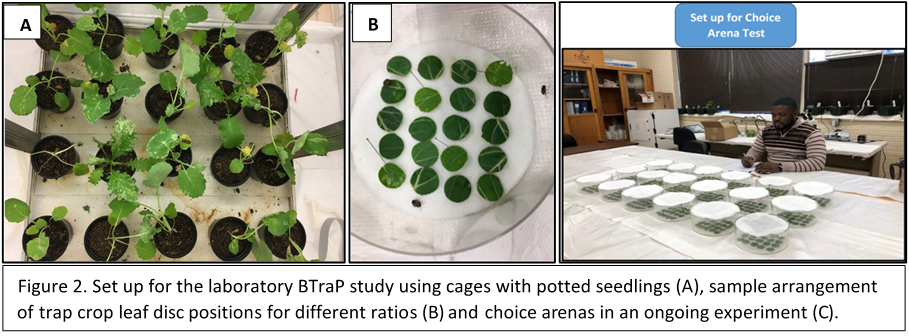
Objective 2. Due to the COVID-19 pandemic, the activities (Objective 2 a & b) that were scheduled for year 2 were not carried out as planned in 2020. This was as a result of university restrictions on access to research fields and laboratories in response to state and federal guidelines. A modified objective 2 will be carried out during the 2021 season with one activity moved to t the final field year (2022) when a no-cost extension request will be made, as part of Objective 3.
In the 2021 field season, we carried out activities in objective 2a validating the results from the laboratory studies carried out in 2020. These involved determining the optimal trap crop ratio, thus effectively completing objective 2. We added a new component in which we evaluated the optimal placement of the trap crop (periphery, borders, or in the center) that had also been examined in the laboratory.
Both trap ratio and position are critical for proper trap function -- with regard to attraction and retention of the pest. The rest of this objective 2 (comparing the trap crop efficiency of fixed versus movable/replaceable traps crops deployed in the optimal ratios) will be carried out in 2022 as part of objective 3, following the COVID-19 related modifications of the objective referred to earlier.
Figures on the left show border (top), perimeter (middle) and center (bottom) placement of trap plants (white flags) using fixed ratios of trap : main crop 7WAT (see trap crop placement earlier in the season below). NCA&TSU Research Farm, 2021.
These three photos (on the left) show the traps in position at the early growth stages of the collard crop.
Field experiment: The 2019 season had heavy rains throughout the region and in some areas such as the Greensboro where NCA&T research farm is located, there were sustained rains for several weeks causing a delay in the onset of transplanting as fields were water logged and/or soggy, and at Greensboro made worse by the use of wheat straw mulch for weed management. We were nonetheless able to plant 3 replications of the experiment instead of four as originally planned as a result of widespread water-logging. Even then, the plant stands were poor and plant health was affected. That notwithstanding, we were able to salvage a good part of the study and collected enough data to enable us to draw reasonable conclusions that were supported by laboratory studies. The experiment in VT performed much better and provided useful information.
The harlequin bug (HB) population was high throughout the season. at both locations. In Greensboro, we computed the ratio of HBs as well as egg masses on the trap mustards to that on the collard (TC:MC). These data were used to plot trap crop retention potential (TCRP) that allows us to test the hypothesis that "if more insects are found on the mustard trap crop as compared to the main crop (collard), there will be concomitantly less damage on the collard". We can therefore make an indirect but reliable inference on actual damage since this was difficult to measure given high caterpillar damage at both locations. Based on this assumption, the highest TCRP values in Greensboro were obtained with the 25% ratio (where FBL > GR > OFM >> SGC), 20% (for FBL and OFM >> GR and SGC). There were clear differences between mustard varieties with the Florida Broad Leaf (FBL) and Old Fashion Mustard (OFM) giving the highest retention potential at 10 and 20% (Figure 3). 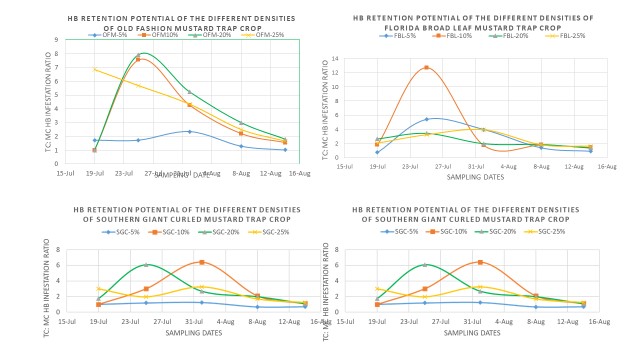
Despite their lower TCRP values, the two other mustards (SGC and GR) also showed a similar trend. We conclude, based on these initial findings, that FBL and OFM were the two best mustard trap varieties in Greensboro, and the trap refuge of 10 and 20% TC:MC ratio the most effective mustard trap ratios (Figure 3). It is important to note that the peak TCRP values in this figure occurred at the optimal harvesting period of the collard, July 23rd and July 31st, for FBL and OFM, and were more spread out for the other two mustards. This overlaps broadly with the results from the lab study which is described below. The results from Blacksburg were similar but with different mustards (SGC > FBL > OFM) having the highest trap retention potential inferred in this case also using the direct HB counts (Figure 4). The 10% and 25% were most effective although there appeared to be an inexplicable peak in 5% with FBL. As earlier indicated, the 20% treatment was inadvertently omitted at this location. 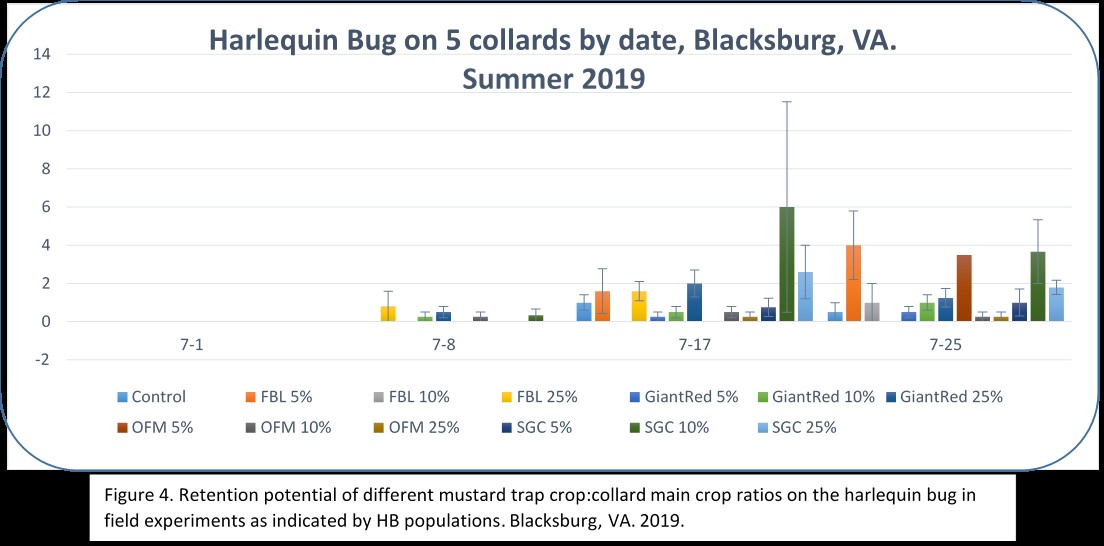
No results are available at this time for Objective 2.
Laboratory study:
Results from the laboratory dual choice arena test (DCAT) using the most promising mustards (FBL and OFM) identified from previous studies show that the 15, 20, and 25% ratios were the most promising (see circle , Figure 5A). Feeding damage (or necrosis) on the TC was expressed against the collard MC as described for the field experiment to test the hypothesis that the longer the insect feeds on the trap, the greater the likelihood of increased retention of the HB. This enables us to determine which TC:MC ratio provides the best retention on the trap crop. The greatest differences in TCRP were obtained on FBL (Figure 5B). Using LSM analysis, significant overall differences were observed (F, 6.6; df, 4; p= 0.0012) between the five ratios, but not between the three top ratios (Figure 5A). Figure 6 shows the plot of the TCRP of all treatments at both locations.
Field Experiments in 2021:
The results from last season confirm lab findings regarding the optimal TC:MC ratio to be 10 and 20 using OFM and FBL. These will be used in the field experiments in 2022 for Objectives 3 and 4. The participating growers will be given the option to use either ratio depending on whether they want to grow a beneficial trap crop (to harvest some leaves for sale or consumption), or a sacrificial trap crop (no harvesting intended). So the intended use eventually determines how much land will be devoted to the trap crop.
Findings from both the field (2 locations) and laboratory studies (Greensboro only) during the first reporting period allow us to draw the following overall inferences:
- In NC, the best ratios are 20 and 25% in the field, and 15, 20, 25 (not significantly different) from the lab experiments with the best mustards being FBL and OFM.
- In VA, the best ratios are 10 and 25% with SGC and to a lesser degree FBL mustard trap crop varieties. The 20% ratio was inadvertently omitted in this location.
- The common ratios between the lab and field studies in NC is 20%; however, there was no difference among the three top TC:MC ratios (15, 20, 25) in the lab study (Figure 5A). No grower wants to devote his/her field to a sacrificial trap crop (not intended for harvest) instead of the desired main crop. We will therefore advance 20 and 15% to the next level of testing unless further testing suggests otherwise. We will use two varieties we will use FBL and OFM in subsequent testing (NC) (Objective 2b).
- The Southern Giant Curled (SGC) mustard has always performed well in VA. This mustard will be retained in that location. In addition, we will also add FBL so that there is one mustard trap variety common to both locations to provide a basis for making location comparisons. This is also important because a collaborating farmer in Virginia wishes to grow the SGC mustard variety.
- What these findings suggest is that it seems reasonable to grow an effective BTraP in only 10-20% of the land area instead of devoting large strips or a perimeter land area to a trap crop. This will be validated with further studies and demonstrations in the final year of the project that will include cost-benefit estimates to show farm profits using these trap crop ratios.
Recent results from both laboratory and field experiments in 2021 confirm the following:
- The optimal trap crop ratio is 10 or 20% using either Old Fashion mustard or Florida Broadleaf mustard. These results were initially initiated in the laboratory in 2020 and completed in 2021. Field experiments performed in 2021 confirmed these findings. In general, the ratio of trap crop:main crop (TC:MC) used by a grower will depend on whether or not they intend to harvest some of the mustard for consumption of marketing (beneficial trap crop) or if they simply want to get rid of the bugs irrespective of the damage to the trap (sacrificial trap crop) as described earlier.
- The other study that was initiated in the laboratory and validated in the field during 2021 was the spatial arrangement of the trap crop relative to the main crop. We evaluated three positions, periphery (the most commonly used trap arrangement), borders or in the center. In both the lab and field experiments, there was no significant difference between the placements. This is an unexpected result given the conventional wisdom which regards the perimeter trap as the gold standard for trap crop placement.
- The findings in 2021 field season indicate that as the adult HB populations increased (3-5x more on the trap mustard than on the main collard crop); as the plants grew older and bigger (during the 5 sampling dates -- 5 - 9 weeks after transplanting -WAT); the adult population peaked at 6WAT, followed by a decline on both the mustard trap crop (sink) and the collard crop. On the other hand the HB nymphal population increased slightly but steadily and peaked later in the season, at 9WAT, when the grower would have already had several harvests (Figure 7A&B)
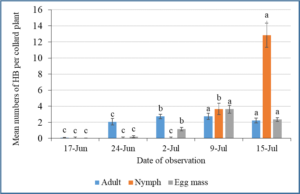
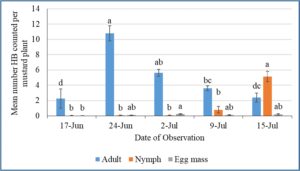 .
.
Figure 7A & B. Populations of HB adults, nymphs and eggs on protected collard main crop (top) and mustard trap crop (bottom).
This is a very significant finding which provides an insight as to when the grower would most likely become concerned (regrading the HB population or the damage inflicted on the collard) leading the grower to take remedial measures, either trap crop replacement -- the movable/replaceable trap crop (this will be investigated during the 2022 season), or treat with insecticide (Figure 7B). They also tell us that at the time the adult bug population peaks on the trap crop (which coincides with the point of high trap degradation from damage) the grower should have made at least three leaf harvests. So, the likelihood of more marketable leaf harvests beyond that point (6 weeks after transplanting) will depend on: a) if the population of the HB is reduced below the action threshold (score of 2-2.5) or b) insecticide is applied. It is critical for the grower to avoid heavy trap crop damaged in order to prevent the HB population from reaching the point of inflection (POI) when the bug population flips over to the main collard crop thus inflicting further damage on collard (Figures 8A top) and potentially diminishing the profits.
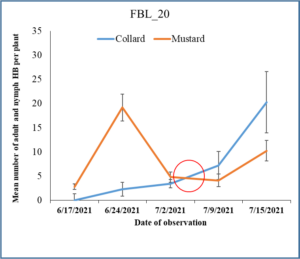
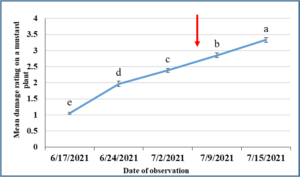
Figure 8A and B. Point of inflection (Fig 8A, top) is attained when the bug population reverts from the mustard trap to the main collard crop. At this point the action threshold (damage level 2-2.5, Fig 8B, bottom) has been exceeded, and the window of opportunity missed (Figure 8B - bottom). Earlier remedial action would be recommended.
During the 2022 field season, we will conduct activities in Objectives 3: to test action needed at the identified juncture/window of opportunity a) to avoid the use of an insecticide to reduce the HB population, on farm and in research plots, and b) evaluate the introduction a new (movable/replaceable) mustard trap plant in place of the damaged TC (which would no longer attractive). Objective 4: determine the cost-benefit of each will be determined based on the two optimum TC ratios (10%, 20%) of the best two mustard varieties (OFM and FBL) on our field
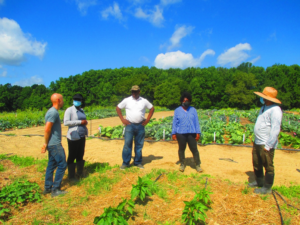
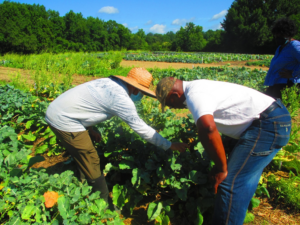
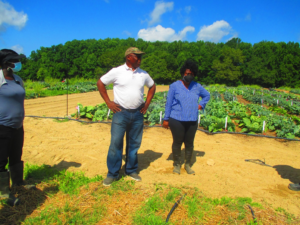
Photographs of collaborating grower (in white short sleeves shirt) from Virginia during his visit to the 2021 experiment at NCA&T Research Farm; what he saw during his visit reinforced his belief in trap cropping.
Results:
Our observations from the 2022 research studies on the final objectives further confirm predictions based on the laboratory and field experiments in 2021, albeit with some mixed results due to environmental and logistic events that were beyond the control of the researchers. The main focus was to verify the need for/value of fixed and replaceable TCs superimposed on the selected TC ratios and placement. These experiments were also to determine on-farm performance (ie grower participation) and the cost-benefit of the different treatments. The latter would normally be conducted at the end of all field work but could not be carried out because of the early termination of funding (6 months before the end of the season as planned, having lost 12 months due to COVID-19). This meant that the co-PI who was tasked with this aspect of the project would not have a salary. We were able to carry out the field experiments at the research farm and at a growers\'s farm, Jeffries Farm, Reidsville, NC. The study at the Research farm has just concluded while the on-farm demonstration is at an advanced stage. The HB population was inconsistent although it clearly indicated that there was no difference in damage between the fixed and replaceable TC treatments as shown in the figures (below), even though the HB population was higher on mustard than on collard at all sampling dates.
The Jeffries Farm had low levels of HBs on the crop throughout the season unlike at the NCAT research farm because of the late planting (Mid-August) at the former. The complete data are yet to be received and processed as harvesting is not over yet. However, based on the observations from both locations at this point (see charts and photographs below) we have made made additions to the model we have been developing for trap crop use on collard (see model figure below in the outcomes section). We believe the model is scalable for use on other crucifers and possibly other crop systems.
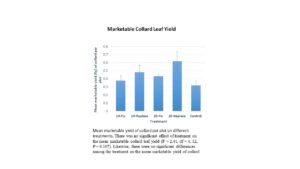
Proposed model for increased TC function (for adoption by the grower community)
- Grow two trap crops varieties (Old Fashion Mustard, and Florida Broad Leaf Mustard) in a staggered sequence along the borders. The mustards should comprise 10-20% of the entire field crop, according to the grower's wishes.
- The interval between the planting/transplanting is 7-10 days with the second plating reversing the border placement of the TCs (see figure).
- Staggered planting allows for a longer presence of flowers on the field; flowers have been established as the most attractive phenological stage, even though the vegetative stage is also attractive. This will account for higher attraction and longer retention and a delay of the point of inflection since the sink component (flowers) will remain active.
- This model has the potential of eliminating the need to replace the trap crop.
- The model is inherently flexible to allow the TC to be placed almost anywhere in the main crop as there appears to be no real advantage of any location (we compared border, periphery and center locations and found no statistical difference among them).
- It is fair to say this model has not been tested on larger farms, but we believe the concept will work if the farm is considered a collective of smaller farms and treated accordingly.
These three photographs from the Jeffries Farm show a great crop of collard and a bonus crop of mustard, and a delighted grower, Mr. Wilbert Jeffries.
The trap worked very well especially so because the harlequin bug population was low where the farm is located. However, the grower realized the reduced damage to the collard leaves this season. That was most likely first because the low population of harlequin bugs was pulled and redirected away from the collard by the mustard trap which has been shown to work quite well even at high harlequin bug populations. The yield from this farm is however yet to be collated as harvesting is still in progress.
Education
The graduate student on the project, Mr. Lawrence Owusu, graduated in the summer of 2021 after successfully defending his MS thesis and completing other graduation requirements. His thesis title was: "Evaluating the impact of density and location of mustard trap crop on the management of harlequin bugs on collard ".
The Research Associate on the project, Deepak Shrestha is currently attending (in person) the Joint Meeting of the Entomological Society of America (ESA), the Entomological Society of Canada (ESC), and the Entomological Society of British Columbia in Vancouver where he presented the findings from the project in an oral talk. Participants at the conference include researchers, administrators, media and extension workers.
The Project PD (LEN Jackai) and co-PD (Beatrice Dingha) are also attending the meeting (virtually and in person, respectively), as a co-authors of the paper being presented.
The full length of the paper has been made available in this report (Products).
Three papers are being written for journal publication, and an Extension Bulletin (web and hard copy) are also being developed to disseminate the recommended Trap Crop model.
Educational & Outreach Activities
Participation Summary:
Collaborating farmers visited the field plots at our research farm in Greensboro. In addition, colleagues, graduate students and other interested parties were amazed on how effective the trap crops were in pulling away the harlequin bugs from collard. They have promised to try trap crops in their farms and gardens, and also plan on recommending this management strategy to their kinsfolk. At least two papers are in preparation.
To date, we have had two research and a number of extension presentations made from this project. Following is a listing:
1
Learning Outcomes
Project Outcomes
-- Collaborating growers who visited the experimental site saw how effective the trap crop deployment was and promised to practice it ion their farms. They will have the opportunity to do so this season (2022). Even my own assistants who had never observed the actual impact of trap cropping now want to try it out as well.
-- Several students learned about the potential for reducing pesticide use in food production using trap crops.
-- The Jeffries farm was delighted with the outcome of the demostration with the mustard trap crop and will continue to use it as a beneficial trap crop so they are able to harvest some mustards as well as the collard. This works very well at their location because they plant a little late in the season when the HB population is already in decline and the damage is not as pronounced as at many other locations, or if the planting is done earlier.
-- Use of insecticide (including organic insecticides) will be greatly reduced as the trap crop model developed in this project is adopted.
-- The TC model will allow the grower to plant collards without need to apply any insecticide if they plant in late summer-early fall.
-- The findings from this project indicate that the grower can use 10 - 20% of a mustard trap anywhere on the farm with good results.
-- Staggered planting of two mustard trap crop varieties (or if preferred, one mustard variety) will eliminate the need for replacing the damaged trap as there will always be enough proffered and still attractive trap crop stages during the leaf harvesting phase. This will sustain good leaf production and eventually farm profits.
Based on findings from the different experiments conducted under this project, we recommend the use of the trap crop model described in the last section for collard (and possible other crucifer) production. The model is flexible in that each user can determine where to locate the trap crop.
The only variables we suggest not be changed are the trap variety. and the optimal population (10-20%) of the crop area.
If this is done as prescribed, there should be little or no need for insecticide to control the harlequin bug. The target of the model is not the caterpillars which may need other remedial action.
If planting is delayed till late summer or early spring, there may be no need for caterpillar control as well as the bugs.
